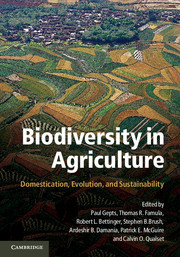Book contents
- Frontmatter
- Contents
- Tables
- Figures
- Foreword
- Contributors
- Acknowledgments
- Introduction: The Domestication of Plants and Animals: Ten Unanswered Questions
- 1 The Local Origins of Domestication
- Section I Early Steps in Agricultural Domestication
- Section II Domestication of Animals and Impacts on Humans
- Section III Issues in Plant Domestication
- Section IV Traditional Management of Biodiversity
- Section V Uses of Biodiversity and New and Future Domestications
- 22 Participatory Domestication of Indigenous Fruit and Nut Trees: New Crops for Sustainable Agriculture in Developing Countries
- 23 The Introduction and Dispersal of Vitis vinifera into California: A Case Study of the Interaction of People, Plants, Economics, and Environment
- 24 Genetic Resources of Yeast and Other Micro-Organisms
- 25 Biodiversity of Native Bees and Crop Pollination with Emphasis on California
- 26 Aquaculture, the Next Wave of Domestication
- 27 Genetic Sustainability and Biodiversity: Challenges to the California Dairy Industry
- Index
- References
23 - The Introduction and Dispersal of Vitis vinifera into California: A Case Study of the Interaction of People, Plants, Economics, and Environment
Published online by Cambridge University Press: 05 June 2012
- Frontmatter
- Contents
- Tables
- Figures
- Foreword
- Contributors
- Acknowledgments
- Introduction: The Domestication of Plants and Animals: Ten Unanswered Questions
- 1 The Local Origins of Domestication
- Section I Early Steps in Agricultural Domestication
- Section II Domestication of Animals and Impacts on Humans
- Section III Issues in Plant Domestication
- Section IV Traditional Management of Biodiversity
- Section V Uses of Biodiversity and New and Future Domestications
- 22 Participatory Domestication of Indigenous Fruit and Nut Trees: New Crops for Sustainable Agriculture in Developing Countries
- 23 The Introduction and Dispersal of Vitis vinifera into California: A Case Study of the Interaction of People, Plants, Economics, and Environment
- 24 Genetic Resources of Yeast and Other Micro-Organisms
- 25 Biodiversity of Native Bees and Crop Pollination with Emphasis on California
- 26 Aquaculture, the Next Wave of Domestication
- 27 Genetic Sustainability and Biodiversity: Challenges to the California Dairy Industry
- Index
- References
Summary
The USA was the fourth largest producer of wine in 2007, behind only France, Italy, and Spain (Castellucci 2008). Since, with just over 523,000 acres of wine grapes (CASS 2008), California produces approximately 90% of all wine produced in the USA (USDA NASS 2009), that fourth-place spot essentially belongs to California. Because the wine grape (Vitis vinifera) is not native to California and was introduced into the state only in the late eighteenth century, the spread of vineyards across California in two and a half centuries represents an unusually successful partnership between humans and plants. The introduction of V. vinifera and the expansion of vineyards were not continuous processes, but rather were the result of boom periods, during which cultivars were introduced and new areas planted, generally followed by periods of decline, when vineyards were abandoned or converted to other crops. Although the initial impetus for each boom period was an increase in the price of wine, which enhanced winery and vineyard profitability, thus encouraging expansion, the specifics of each boom period differed, both in the type of grapes planted and the geographic areas developed. This brief history reviews the major periods of planting within California, examining the causes for the increased production, the locations developed, and the cultivars chosen.
Vitis vinifera is the principal species of the genus Vitis used for wine production. Derived from the wild V. silvestris, V. vinifera (literally “wine bearer” in Latin) is unusual in both the size and high sugar concentration of its berries, making it excellent for wine production. Heterozygous, it does not breed true from seeds, and by the Roman period early agriculturists had found that the best way to preserve grape plants with desired characteristics was through some form of woody propagation, producing distinct cultivars. Writing in the first century AD, Pliny the Elder described over 80 different varieties (Unwin 1996) and Lucius Columella observed that the same cultivar differed in production from vineyard to vineyard, that some varieties were particularly suited to certain locations, and that some locations were better than others (Columella 1941). As Columella put it, a “vine. . .;though only moderately fruitful should be our choice, if only we have a piece of ground where the flavor of the wine is distinguished and costly” (Columella 1941:235).
- Type
- Chapter
- Information
- Biodiversity in AgricultureDomestication, Evolution, and Sustainability, pp. 502 - 514Publisher: Cambridge University PressPrint publication year: 2012



